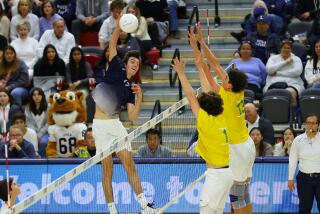Kelly Has Won Everything Except Respect : Recognition Eludes the Best Women’s Badminton Player in America
- Share via
In the 18 years Judianne Kelly has participated in amateur and professional badminton, she has won just about every championship, award and honor imaginable.
For the record:
--She has won a total of 15 national championships in three divisions--two in singles, six in doubles and seven in mixed doubles.
--She has been a member of the last four U.S. Uber Cup teams (the badminton equivalent of tennis’ Davis Cup team).
--And, less than two months ago, the 36-year-old captured the sport’s elusive Triple Crown by winning national titles in singles, doubles and mixed doubles in the same season. Kelly’s Triple Crown was the first in badminton in 13 years.
But what eludes Kelly, she says, is respect.
Although she has established herself as the best women’s badminton player in America, her vast accomplishments have been all but unnoticed because her sport is considered a minor one in this country.
“In Indonesia, you’re a national hero if you’re the No. 1 badminton player,” Kelly said. “I mean, you get a Mercedes and everything. Basically, they take care of you for the rest of your life. Over here, they don’t even know who I am. They say, ‘Judi who?’ ”
While most top players from other countries can earn a living playing badminton, for the past 13 years, Kelly has had to earn her living as an intermediate school physical education instructor. She lives in Costa Mesa and teaches at Irvine Intermediate School in the Garden Grove School District.
Despite the fact that the 1984-85 season was the finest of her career, she says she earned just $3,000 from the sport, including prize and sponsorship money.
A large part of badminton’s recognition problem in this country is that it didn’t gain professional status until 1978, and since then, it has received extremely limited exposure. Television coverage of badminton is nearly non-existent and that is mainly because of the nature of the sport.
“It’s hard to get badminton on TV,” Kelly said. “The shuttle travels at more than 125 m.p.h., and rallies can easily last 20 to 50 shots. . . . It’s real hard to film it so the audience can actually see the skill involved. Because of the lighting (a dimly lit court is most conducive for playing badminton), they’ll shoot from the back, so you can’t see the side-to-side (movement), you can’t see the quickness.”
Another dilemma associated with the sport, she says, is the inherent identity problem. Generally, when one thinks of badminton, visions of slapping a plastic birdie around with the family on a Sunday afternoon picnic come to mind. But the kind of badminton Kelly plays is played indoors, and is as grueling as other racquet sports such as racquetball and tennis.
“When you see people play badminton, they make it look easy,” she said. “But if you had to go on the court, you’d realize how much is really involved. People come up to me all the time and say, ‘I think I could get five points off you,’ but there’s just no way. I tell them, ‘You couldn’t get one point off me.’ . . . But then they come over and play, and that’s how they learn. “
Kelly taught a similar lesson to most of her opponents this season.
She has traditionally been a consistent doubles and mixed doubles performer, but she hadn’t won a national singles title in 10 years before this season. Then, at the U.S. National Badminton Championships played in Atlanta in April, her 3-11, 12-11, 11-5 victory over Manhattan Beach’s Joy Kitzmiller in the women’s singles final culminated a string of six pro tournament title wins.
“Every single game I hung in there and fought,” Kelly said. “She (Kitzmiller) had me 10-7 (in game two), so she was one point away from winning it (the match). But I just said, ‘She’s not gonna win.’
“I fight a little bit more (than most other players). I have a little more desire. I never, ever, give up. I think some women have the tendency to just say, ‘forget it.’ ”
Another advantage for Kelly is her dedication to training.
During the season, Kelly works out twice a week with her coach, Vicki Toutz, who is also the coach of the U.S. Uber Cup team and the badminton team at Garden Grove High School. She also practices once a week with Sombat D’Hammabusaya, a former Thai national player and former Uber Cup coach. In addition, she plays against another male player at least once each week, because, as she said, “none of the women are strong enough players for me.”
Her off-season regimen consists of activities such as bicycling, racquetball, tennis and golf, plus her usual conditioning program of push-ups, sit-ups, jumping rope and court drills.
Having trained so hard for so many years only to receive such frugal rewards has made Kelly uncertain about her future in badminton.
When asked if she’ll be returning next year to try for a second Triple Crown, Kelly replied, “I don’t know. . . . It’s taken me so long to win (the singles title). I know what I’ve gone through every year. I’m not sure what I’m going to do right now. Staying in that kind of shape all year long and having the pressure of being No. 1 is tough.”
Don’t expect Kelly to abandon badminton altogether, however. She said although she isn’t sure whether or not she will continue to compete as a singles player, she will keep playing doubles with Pam Brady of Michigan and mixed doubles with Mike Walker of Leucadia.
And despite her dismay over her lack of recognition, it doesn’t seem likely Judianne Kelly will ever adopt a sedentary life style.
“People come up to me and say, ‘Are you still playing badminton?’ And I say, ‘Yeah, I’m the champ ,’ ” she said. “I guess they think I should be in a wheelchair or something. I just tell them, ‘Just because your main sport is gardening doesn’t mean mine has to be.’ ”
‘In Indonesia, you’re a national hero if you’re the No. 1 badminton player. I mean, you get a Mercedes and everything. Basically, they take care of you for the rest of your life. Over here, they don’t even know who I am. They say, ‘Judi Who?’ ‘
More to Read
Go beyond the scoreboard
Get the latest on L.A.'s teams in the daily Sports Report newsletter.
You may occasionally receive promotional content from the Los Angeles Times.










